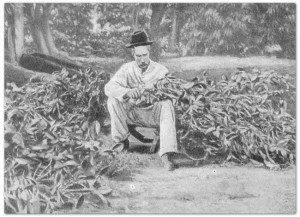Profitable Egret Plumes
The fearless riders of the Ilanos, those wide plains which are only equalled by the pampas of Argentina, are expert cattlemen; there is the nucleus of a mercantile marine in the Venezuelan owned and operated steamship line which has the monopoly of navigation of the river Orinoco, and there is a unique occupation of certain interior regions near water – that of the men who tend the garzeros.
The garza is a bird of the heron family yielding the dainty white feathers known as egrets, grown and shed in the breeding season. These birds come annually to well-known open, watered areas in such numbers that the ground is white as snow when they settle, and the locality, the garzero, is defined by law and patrolled by armed watchers for the birds’ protection. The same authorised guards collect the dropped feathers at the end of the season; any man found selling the feathers without a licence is sent to gaol.
Religion and Strong Family Ties
The Venezuelan, apart from the civic centres, is a tough, open-air, individual, temperate, inclined to piety, accustomed to the lack of many comforts which are necessities in other climes. The part that women play in Venezuelan affairs, whether in a beautiful house in Caracás or a hut on a river bank, is purely domestic; the woman worker is practically unknown, and the feminist movement in Venezuela is not perceptible.
The hold of the Roman Catholic church is strong upon the women folk and they are as a rule perfectly contented with the interests of their large families. Here, as in many other parts of South America, relatives have a close call upon each other, and there is no out-of-work member of a family who cannot transfer his hammock and his wife and offspring to the house of a cousin or uncle, sure of receiving a welcome until he gets another job, when he will probably receive in like manner half a dozen relatives of his spouse.
With two chief exceptions, the centres of population of Venezuela are clustered close to the Caribbean. They are ports, with their backs to the vast national territory. Here is the asphalt port, Cristobal Colon; Guanta, shipping coal from the state-owned mines; Puerto Cabello, with its British-owned frozenmeat factory, drawing supplies from the cattle plains; Maracaibo, sending out sugar and oil, and Colombia’s coffee from the Bucaramanga region; La Guayra, doing the chief business of the country; La Vela, Cumanà, Carùpano, shipping coconut fibre and copra and pearls and the famous rum, the ron anciado sold in every cantina.
Damp and Deadly Hinterland
Behind lies a huge region, with great areas of water-threaded forest that are almost as they were in the Stone Age, where the trader seeking supplies of serrapia (tonka beans) and balata rubber takes to the river roads, in native piragua or curial (dug-out), his life in his hands. He fears the ubiquitous biting insects of the sweltering, encompassing forest as much as he fears the blow-gun and the curare poison of the wild Ventuari Indians; he risks death in the many cataracts of the Orinoco’s tributaries, or in an encounter with the caiman (alligator) that infests these banks. The headquarters of this trading is the odd river-port of Ciudad Bolivar, situate three hundred miles from the Orinoco’s mouth and fifty miles above the junction of the Caroni, that runs from the south and the legend-haunted mountains of Pacaraima; wood-built, cobble-paved, electric-lit, the town lies steeply on the river bank, a precarious, jungle-surrounded stronghold, where gambling runs high and lives are cheap.
The Ilanos, the cattle plains where the gauchos are bred, and the fine hilly country from which the rivers run, form another world. The trading centre for the stock-breeder of the plains is San Fernando de Apure, far removed from gracious, bedecked, Europeanised Carácas by more than mileage.
With a population of about seven persons to each square mile Venezuela will be for many generations a “new” country, with plenty of room to grow; so new, indeed is she, that only now are her boundaries being definitely inscribed. With Brazil and with British Guiana a definite conclusion was reached last century; but the question with Colombia has only recently been settled two commissions of Swiss experts.
Above: Cleaning orchids in a forest of tropical Venezuela. Venezuela lies wholly within the tropics, and full one half of the country is forest, penetrable only with considerable difficulty. These dense forests, much choked with undergrowth, abound in wild life, and among the exuberant tangled greenery orchids flourish abundantly. Here the orchid-lover can find numerous fantastic flowers in glowing and exquisite colours
The country is divided into three separate zones: the mountainous, the plain, and the forest region. Of these, the first is formed by an arm of the Andes range which passes through Trujillo and Tachira, and along the sea-line to the Paria peninsula; the region of the plains extends to the margin of the giant Orinoco river; and the forest area from the right bank of that river to the frontier of Brazil. In the first the climate is very variable, from cold to salubrious; in the second it is for the most part warm and healthy; and in the forests, tropical and unhealthy. The chief mountain peaks are the Sierra Nevada (16,437 feet), Naiguata and Maraguata. Volcanoes are absent, but thermal springs exist.








Leave A Comment
You must be logged in to post a comment.